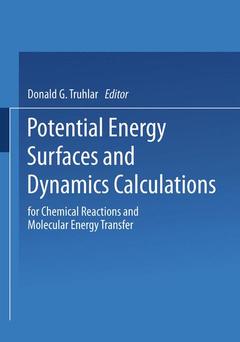1. Overview of Unimolecular Dynamics.- 2. Effect of potential energy surface properties on unimolecular dynamics for a model alkyl radical dissociation reaction: H-C-C ? H + C=C.- 3. Vibrational predissociation of van der Waals molecules and intermolecular potential energy surfaces.- 4. Potential surface properties and dynamics from molecular spectra: A time-dependent picture.- 5. Calculation of potential energy surfaces for HCO and HNO using many-body methods.- 6. Theoretical studies on the unimolecular decomposition of methanol.- 7. Potential energy surfaces in excited states of saturated molecules.- 8. Interpolation of multidimensional potential surfaces by polynomial roots.- 9. Classical trajectory studies of the formation and unimolecular decay of rare gas clusters.- 10. Potential energy characteristics for chemical reactions.- 11. Reaction path Hamiltonian for polyatomic systems: Further developments and applications.- 12. Overview of Reactive Scattering.- 13. A quasiclassical trajectory study of product rotational, angular, and projection distributions in the OH + H2 ? H2O + H reaction.- 14. Theoretical studies of selected reactions in the hydrogen-oxygen system.- 15. Exact quantum reaction probabilities for the collinear O(3P) + H2 reaction on an Ab initio and diatomies-in-molecules potential surface.- 16. Reactive scattering resonances and their physical interpretation: The vibrational structure of the transition state.- 17. Quasiclassical differential cross sections for reactive scattering of H + H2 on LEPS and Porter-Karplus potential surfaces.- 18. Reaction, dissociation, and energy transfer as a function of initial state for H + H2 on an accurate ab initio potential energy surface.- 19. Rate constant calculations for the H + H2 and F + H2 reaction systems within the infinite-order sudden approximation.- 20. Quantum dynamics of the three-dimensional F +H2 reaction: Wavefunction density analysis.- 21. Potential energy surfaces for the H + HX (X = F, Cl, Br, I) abstraction and exchange reaction channels calculated by the modified DIM method.- 22. Potential energy surface and cross sections for the H?(D?) + H2(D2, HD) ion-molecule reactions.- 23. Reactions of the D state of oxygen and carbon.- 24. Determination of the bottleneck regions of potential energy surfaces for atom transfer reactions by variational transition state theory.- 25. Laser-induced nonadiabatic collision processes.- 26. Application of the energy minimization method to a search for the transition state for the H2 + D2 exchange reaction.- 27. Theoretical studies of reactions at transition metal centers.- 28. Overview of Non-Reactive Scattering.- 29. Scattering of ions by polyatomics and solid surfaces: Multicenter short-range interactions.- 30. On CC and CS descriptions of phase-sensitive cross sections: Computations for He + HCl.- 31. Rainbow scattering in inelastic molecular collisions.- 32. Effect of laser frequency on a collision-induced radiative process.- 33. Collisional excitation of H2O by O-atom impact: Classical dynamics on an accurate Ab initio potential energy surface.- 34. Interaction potentials for gas-surface dynamics.- 35. Atom-surface potential information from low-energy atom-surface scattering.- 36. Classical trajectory studies of keV ions interacting with solid surfaces.- Appendix: Units.




